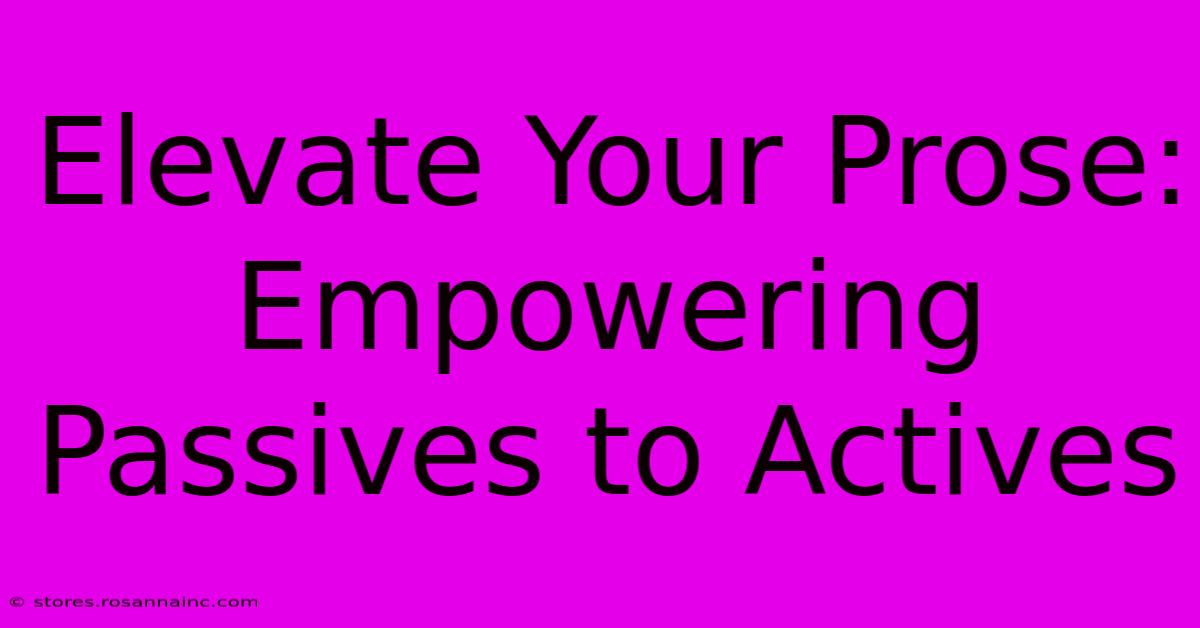Elevate Your Prose: Empowering Passives To Actives

Table of Contents
Elevate Your Prose: Empowering Passives to Actives
Passive voice. It's a grammatical construct that often lurks unseen, weakening sentences and muddying meaning. While it has its place, overusing passive voice can make your writing sound weak, indirect, and even confusing. This article will show you how to identify and transform passive sentences into their stronger, more active counterparts, ultimately elevating your prose.
Understanding the Passive Voice
Before we delve into the transformation process, let's clearly define what constitutes passive voice. In passive constructions, the subject receives the action rather than performing it. The verb typically includes a form of "to be" (is, are, was, were, been, being) followed by a past participle.
Example of Passive Voice:
The report was written by John.
Notice how the report (the subject) is acted upon. John, the actor, is relegated to a prepositional phrase.
Why Active Voice is Superior
Active voice offers several significant advantages:
- Clarity: Active voice makes it immediately clear who is performing the action. This directness improves readability and comprehension.
- Conciseness: Active sentences are often shorter and more impactful. Eliminating unnecessary words strengthens your writing.
- Strength and Authority: Active voice conveys confidence and authority. It makes your writing more assertive and persuasive.
- Engagement: Active voice directly engages the reader, creating a more dynamic and impactful reading experience.
Identifying Passive Voice in Your Writing
Spotting passive sentences might seem challenging initially. Here are some key indicators:
- Form of "to be" + Past Participle: This is the most reliable sign. Look for verbs like "is written," "was completed," "are being considered," etc.
- Vague or Missing Actor: If you can't easily identify who is performing the action, it's likely passive voice.
- Prepositional Phrases: While not always an indicator, excessive use of phrases beginning with "by" often suggests passive voice.
Transforming Passive to Active: A Step-by-Step Guide
Let's convert our passive example into active voice:
Passive: The report was written by John.
Active: John wrote the report.
Here's a general method for transforming passive sentences:
- Identify the actor: Who or what performed the action in the passive sentence?
- Identify the action: What verb describes the action?
- Make the actor the subject: Place the actor at the beginning of the sentence.
- Use the active form of the verb: Replace the passive verb construction with the active equivalent.
- Reword as needed: Sometimes minor adjustments are necessary for clarity and flow.
Advanced Techniques and Exceptions
While active voice is generally preferred, there are situations where passive voice might be appropriate:
- When the actor is unknown or unimportant: "The window was broken."
- When you want to emphasize the action, not the actor: "The experiment was carefully conducted."
- To maintain objectivity: In scientific writing, passive voice can be useful for emphasizing the results.
However, overuse should still be avoided. Even in these cases, consider whether you can rephrase to achieve a similar effect while still using active voice.
Practice Makes Perfect
The key to mastering active voice is practice. Review your own writing, paying close attention to verb constructions. Make a conscious effort to convert passive sentences to active ones. Over time, you'll develop a keen eye for identifying and transforming passive constructions, resulting in clearer, more impactful, and engaging prose. By actively engaging with these techniques, you'll significantly elevate your writing skills.

Thank you for visiting our website wich cover about Elevate Your Prose: Empowering Passives To Actives. We hope the information provided has been useful to you. Feel free to contact us if you have any questions or need further assistance. See you next time and dont miss to bookmark.
Featured Posts
-
Connect With Your Loved Ones The Ultimate Guide To Finding The Perfect New Years Card
Feb 04, 2025
-
Unveiling Detroits Hidden Gem The Dossin Museums Secrets Revealed
Feb 04, 2025
-
The Perfect Christmas Bouquet Let These Popular Flowers Spread Holiday Cheer
Feb 04, 2025
-
Level Up Your Look How To Choose The Perfect D And D Gel Colors For Every Class
Feb 04, 2025
-
Elevate Your Health With Palm Power Rediscover The Healing Touch Of Nature
Feb 04, 2025
